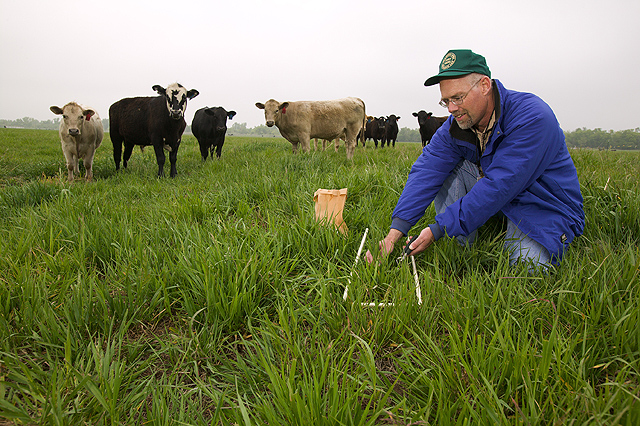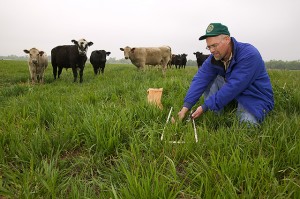
In an experimental pasture at the Grazinglands Research Laboratory near El Reno, Oklahoma, ecologist Brian Northup collects samples to describe availability and quality of forage.
Stephen Ausmus / USDA


In an experimental pasture at the Grazinglands Research Laboratory near El Reno, Oklahoma, ecologist Brian Northup collects samples to describe availability and quality of forage.
Stephen Ausmus / USDA

Stephen Ausmus / USDA
In an experimental pasture at the Grazinglands Research Laboratory near El Reno, Okla., ecologist Brian Northup collects samples to describe availability and quality of forage.
The federal government will use a grassland laboratory near El Reno to research the regional effects of climate change for U.S. farmers, ranchers and foresters, the U.S. Department of Agriculture announced Wednesday.
The Grazinglands Research Laboratory was picked to be one of the country’s seven “climate hubs,” where federal and state agencies, university scientists and other researchers will generate data to help landowners “adapt and adjust their resource management,” federal officials said in a statement.
Climate change-related drought, fires, floods and invasive pests will be a central focus at the hubs.
The USDA’s Agricultural Research Service administrates Grazinglands, which is used to study crop, forage and livestock production, and land use and resource management.
Grazinglands already functions as a hub where in-state researchers study climate change, but the federal designation will expand collaboration, Director Jean Steiner tells The Oklahoman‘s Adam Wilmoth.
“Our laboratory already had considerable investment in climate-related research, including adaptation to climate variability, which is relevant to the climate hub mission,” she said.
“We decided to reallocate some of those resources to having a very strong technology transfer focus. We think that will strengthen our program across the board, make it higher-impact research. We think it will leverage the research dollars we have.”
Regional hubs were also named at sites in Iowa, New Hampshire, North Carolina, Colorado, Oregon and New Mexico, and a trio of smaller “sub-hubs” are planned for California, Michigan and Puerto Rico.